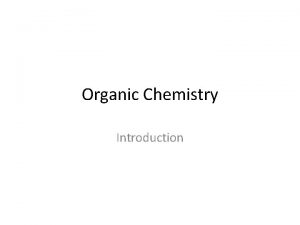Introduction to Organic Chemistry Atomic Theory In chemistry














- Slides: 14

Introduction to Organic Chemistry

Atomic Theory • In chemistry and physics, atomic theory is a scientific theory of the nature of matter, which states that matter is composed of discrete units called atoms. • The word atom comes from the Ancient Greek adjective atomos, meaning "indivisible".

• Electrons exist in energy levels that surround the nucleus of the atom. The energy of these levels increases as they get farther from the nucleus. The energy levels are called shells, and within these shells are other energy levels, called subshells or orbitals. , that contain up to two electrons.

Electronegativity • Electronegativity is a measure of an atom's ability to attract the shared electrons of a covalent bond to itself. If atoms bonded together have the same electronegativity, the shared electrons will be equally shared.

• If the electrons of a bond are more attracted to one of the atoms (because it is more electronegative), the electrons will be unequally shared. If the difference in electronegativity is large enough, the electrons will not be shared at all; the more electronegative atom will "take" them resulting in two ions and an ionic bond.

Bonding • Ionic Bond Ionic bonding is important between atoms of vastly different electronegativity. The bond results from one atom giving up an electron while another atom accepts the electron. Both atoms attain a stable nobel gas configuration.

• Covalent Bond A covalent bond is formed by a sharing of two electrons by two atoms. A hydrogen atom possessing the 1 s 1 electron joins with another hydrogen atom with its 1 s 1 configuration. The two atoms form a covalent bond with two electrons by sharing their electron

Polar Covalent Bond • Polar covalent bonds are a particular type of covalent bond. • In a polar covalent bond, the electrons shared by the atoms spend a greater amount of time, on the average, closer to the Oxygen nucleus than the Hydrogen nucleus. This is because of the geometry of the molecule and the great electronegativity difference between the Hydrogen atom and the Oxygen atom. • • You should note this molecule is not an ion because there is no excess of proton or electrons, but there is a simple charge separation in this electrically neutral molecule.

Polar Covalent Bond • Water is not the only molecule that can have polor covalent bonds. Examples of other molecules that have polar covalent bonds are Peptide bonds and amines. • The biological consequence of polar covalent bonds is that these kinds of bonds can lead to the formation of a weak bond called a hydrogen bond.

Importance of Carbon • • It has a “central” role in all living organisms. It has 4 valence electrons. It makes 4 covalent bonds. It can bond with any element, but priorities to bond with other carbon atoms and make long chains

Types of Carbon Bonds

Various ways to present the bonding

Classification of Organic Compounds

 Ib chemistry organic chemistry
Ib chemistry organic chemistry Inorganic vs organic chemistry
Inorganic vs organic chemistry What is organic chemistry
What is organic chemistry Relative atomic mass of beryllium
Relative atomic mass of beryllium What are the trends in the periodic table
What are the trends in the periodic table Increasing ionic radius
Increasing ionic radius Abundance calculation chemistry
Abundance calculation chemistry Atomic mass and atomic number difference
Atomic mass and atomic number difference Atomic number vs atomic radius
Atomic number vs atomic radius Founder of organic chemistry
Founder of organic chemistry Soap organic chemistry
Soap organic chemistry Ester organic chemistry
Ester organic chemistry Cooh
Cooh Organic chemistry david klein 3rd edition
Organic chemistry david klein 3rd edition Ee organic chemistry
Ee organic chemistry


























